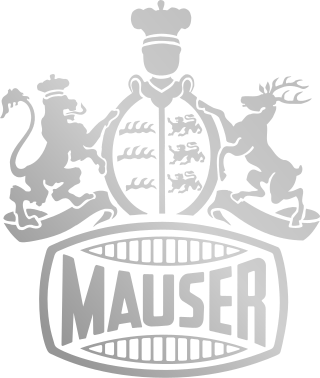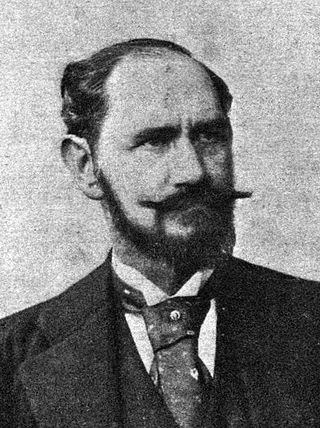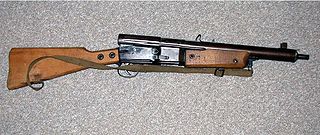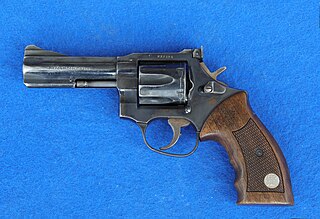
A semi-automatic rifle is an auto-loading rifle that fires a single round of ammunition at a time. It uses part of the fired cartridge's energy to eject the case and automatically loads another cartridge into its chamber. This is in contrast to bolt-action or lever-action rifles, which require the user to manually chamber a new round before they can fire again, and fully automatic rifles, which fire continuously while the trigger is held down.

Mauser, originally the Königlich Württembergische Gewehrfabrik, was a German arms manufacturer. Their line of bolt-action rifles and semi-automatic pistols was produced beginning in the 1870s for the German armed forces. In the late 19th and early 20th centuries, Mauser designs were also exported and licensed to many countries, which adopted them as military and civilian sporting firearms. The Gewehr 98 in particular was widely adopted and copied, becoming one of the most copied firearms designs and it is the foundation of many of today's sporting bolt-action rifles. Around 10 millions Gewehr 98 style rifles were produced.

The Gewehr 43 or Karabiner 43 is a 7.92×57mm Mauser caliber semi-automatic rifle developed by Germany during World War II. The design was based on that of the earlier G41(W) but incorporated an improved short-stroke piston gas system similar to that of the Soviet SVT-40.
Carl Walther GmbH , or simply known as Walther, is a German firearm manufacturer, and a subsidiary of the PW Group. Founded by Carl Walther in 1886, the company has manufactured firearms and air guns at its facility in Germany for more than 100 years. Walther Arms, Inc. is the United States Walther business unit and is based in Fort Smith, Arkansas.

A semi-automatic pistol is a repeating handgun that automatically ejects and loads cartridges in its chamber after every shot fired, but only one round of ammunition is fired each time the trigger is pulled. The pistol's fire control group disconnects the trigger mechanism from the firing pin/striker until the trigger has been released and reset manually, unlike the self-cycled firing mechanism in fully automatic pistols.

The Walther PP series pistols are blowback-operated semi-automatic pistols, developed by the German arms manufacturer Carl Walther GmbH Sportwaffen.
Blowback is a system of operation for self-loading firearms that obtains energy from the motion of the cartridge case as it is pushed to the rear by expanding gas created by the ignition of the propellant charge.

The Walther P5 is a 9mm semi-automatic pistol developed in the mid-1970s by the German small arms manufacturer Carl Walther GmbH Sportwaffen. It was designed with the German police forces in mind, who sought to replace existing 7.65mm pistols with a modern service sidearm incorporating enhanced safety features and chambered in 9×19mm Parabellum. A subsequent bid resulted in the Walther P5 being introduced into service alongside the SIG Sauer P225 and Heckler & Koch P7.

The Walther P38 is a 9 mm semi-automatic pistol that was developed by Carl Walther GmbH as the service pistol of the Wehrmacht at the beginning of World War II. It was intended to replace the comparatively complex and expensive to produce Luger P08. Moving the production lines to the more easily mass producible P38 once World War II started took longer than expected, leading to the P08 remaining in production until September 1942 and copies remained in service until the end of the war.
The 9×19mm MP 3008 was a German last ditch submachine gun manufactured towards the end of World War II in early 1945.

Ferdinand Ritter von Mannlicher was an Austrian engineer and small arms designer. Along with James Paris Lee, Mannlicher was particularly noted for inventing the en-bloc clip charger-loading box magazine system. Later, while making improvements to other inventors' prototype designs for rotary-feed magazines, Mannlicher, together with his protégé Otto Schönauer, patented a perfected rotary magazine design, the Mannlicher–Schönauer rifle, which was a commercial and military success.

The Volkssturmgewehr is the name of several rifle designs developed by Nazi Germany during the final months of World War II. They share the common characteristic of being greatly simplified as to adapt with the severe lack of resources and industrial capacity in Germany during the final stages of the war. The Volkspistole was a partner program, almost identical, but for pistols instead.
The StG 45(M) (abbreviation of Sturmgewehr 45, "Assault Rifle 45") sometimes referred to as the MP 45(M), was a prototype assault rifle developed by Mauser for the Wehrmacht at the end of World War II, using an innovative roller-delayed blowback operating system. It fired the 7.92×33mm Kurz (or "Pistolenpatrone 7.9mm") intermediate cartridge at a cyclic rate of around 450 rounds per minute.

The Carabinetta Automatica O.V.P was a submachine gun developed in Italy.

The 7.92×33mm Kurz is a rimless bottlenecked intermediate rifle cartridge developed in Nazi Germany prior to and during World War II, specifically intended for development of the Sturmgewehr 44. The ammunition is also referred to as 7.9mm Kurz, 7.9 Kurz, 7.9mmK, or 8×33 Polte. The round was developed as a compromise between the longer 7.92×57mm full-power rifle cartridge and the 9×19mm Parabellum pistol cartridge.

Manurhin is a trademark used by Chapuis Armes since 1998. It is used to designate the Manurhin MR 73 revolver family, manufactured at Saint-Bonnet-le-Château, France.

Grossfuss Sturmgewehr was a prototype assault rifle designed during World War II by Kurt Horn at the Grossfuss company better known for their contribution to the German arsenal made with the MG 42.

The Maschinenkarabiner 42(H) or MKb 42(H) (machine carbine Model 1942 (Haenel)) was an early German assault rifle firing an intermediate round of World War II. Designed in 1940 – 1941 by Hugo Schmeisser working for C. G. Haenel Waffen und Fahrradfabrik, several thousand were made and the gun was used on the Eastern Front in 1943.

The Maschinenkarabiner 42(W) (German: "machine carbine model 1942 (Walther)" ) or MKb 42(W) was an early German assault rifle designed in 1940-41 by Walther during World War II. The Mkb 42(W), and the more successful Maschinenkarabiner 42(H) designed by Haenel, were predecessors of the Sturmgewehr 44 (StG 44) assault rifle.
















